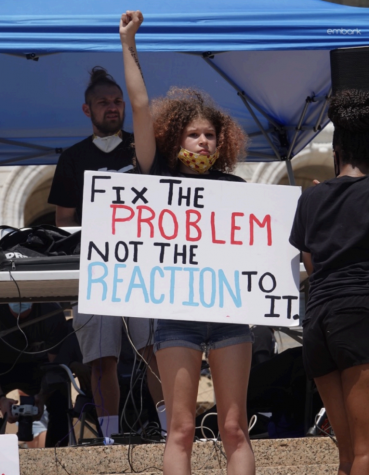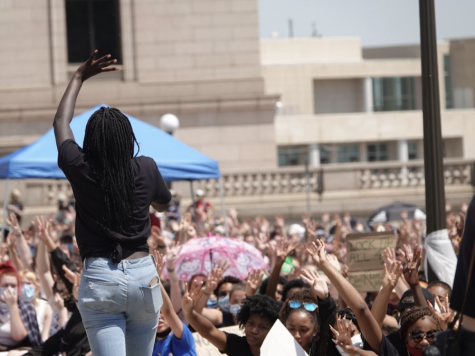Finding Your Place in the Revolution
December 18, 2020
At the beginning of June, eleven of us (ten young women and one young man) started “The Sit To Breathe Project” and organized a sit-in at the capitol. We never would’ve guessed that over 6,000 people would come to stand up for Black lives; we were shocked. But we were also ready. We stayed focused and capitalized on each of our strengths. There was a moment when I was looking out at that sea of people, the Blackhawks were circling above, the tanks flanking us and the armed guard dispersed, and I had this thought: “Mimi, what are you doing? Are you crazy?” I then answered myself, almost as quickly. I became flooded with all the affirmation that has been instilled in me by my family and by my role models. I knew I was good for it. I had everything I needed inside of me to carry me through it.
As a kid in the Minneapolis Public Schools system, I grew up in the same segregated schools as everyone else—though being black means you notice it more than any of the white kids (and I knew mostly white kids). Southwest likes to preach its diversity, but it is as segregated as they come. After freshman year, I never was in any classes with POC except the very few token students in the same position as me. During my sophomore year, I met interim principal Dr. Karen Wells. She was the first black woman in leadership that I had ever met in the schools. It sparked me and we are very close now. Her voice is one of the clearest in my head when I channel my power. After meeting Dr. Wells, I became hungry to meet more women of color beyond my family. Meeting Dr. Wells was the first time I stopped thinking about what was projected onto me and I started thinking about who I am as an individual. Toni Morrison said, “Definitions belong to the definers, not the defined.” That resonates with me. The definitions that had been projected onto me had always felt like a burden. Defining myself and living for myself, not as a token but as an individual, was critical. I also think a lot about Chimamanda Adiche and the “single story,” about how important it is to see and hear a story that you can relate to. That’s hard to have happen when you’re a black girl in Linden Hills going to Southwest. The books I’ve read by powerful writers like these come through for me during moments when I need to channel my power.
Humanity is in a desperate place, we cannot afford to lose out on the creativity that comes from its many lenses. My mom calls young women like me “Key Holders” because it’s going to take something other than homogeneous whiteness to move us out of a global crisis. We need all voices onboard. This month, I was struck by the mayor of DC, Ms. Muriel Bowser, who is having the street painted and is changing the street name to “Black Lives Matter.” This is such an epic, strategic move. Name changing—as we well know, in our city, with the barriers facing Bde Maka Ska—is powerful. Names carry symbolism. Ms. Bowser is a testament to what happens when Black women are in leadership and have a voice at the table. Renaming everything isn’t the whole battle but it is the message that the names carry that can help to further the movement.
For me, and in many ways, because I am a black woman, I had to go out and find what I needed. My family helped me connect with the community, so that the truth about who I am and what I could be was revealed to me. The truth being: I am powerful, my experience is valuable and necessary, my intellectual property is mine, my body is mine. My community of role models is everything to me. They helped me see the “yes” when the rest of the world said no. The “no” is a lie; I CAN and should try to shape the world. We all have a role to play on every pillar of racism. We have to know our place in the movement and be fearless.
Black girls need to take up space and use their voice, that’s step one. Step two is knowing that your life and experience matter, your perspective is the one that you need to be paying attention to. When you harness all that magic you can start to lift a lot of people. For me, organizing at the capital was the obvious next step when the truth about police brutality recently hit the white mainstream. We are not finished by a long shot and we have big plans.
My hope is that everyone finds their place in the revolution. White people might have to hit rock bottom and experience shame about racism, but the idea is that they learn to understand how white supremacy works, and that their shame propels them to service, to follow leadership instead of getting defensive and fragile. Meanwhile, I have my job. I lean on my role models, my support community, and my intuition to inspire me and show me the way.


